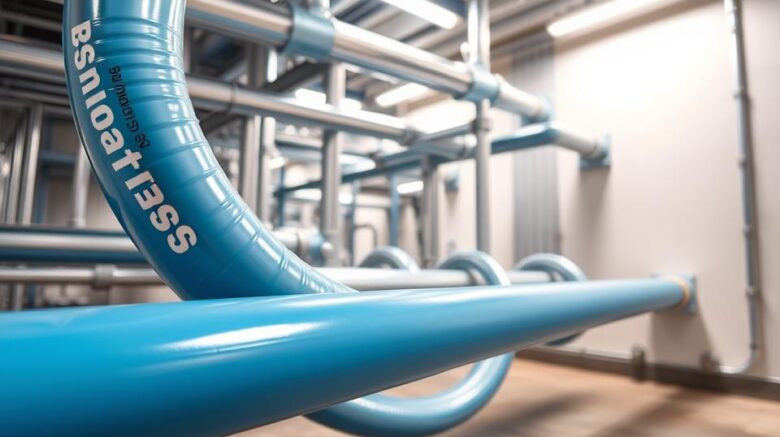PVC Pipe for Air Compressor Lines: Your Complete Guide
A burst compressed air line can discharge energy comparable to a stick of dynamite—did you know? Many facilities still use piping systems made from risky materials, unaware of the dangers. Read on to discover why PVC pipe for air compressor lines choices demand top-tier safety.
Despite growing interest in certain materials, OSHA strictly prohibits their use in above-ground applications. Over time, exposure to oils and temperature changes weakens them, leading to catastrophic failures. Those so-called safe pressure limits don’t eliminate explosion risk.
For reliable alternatives, Installation Parts Supply offers durable solutions like aluminum. Using approved materials saves you from fines and enhances safety. Let’s explore how to build a safer system.

Key Takeaways
- OSHA bans certain materials due to explosion risks.
- Heat and cold swings slashes claimed pressure capacity.
- Brittleness worsens over time, increasing failure risks.
- Aluminum piping offers a safer alternative.
- Invest wisely to dodge fines and protect staff.
Why You Shouldn’t Use PVC for Compressed Air
PVC makers caution never to employ it in high-pressure air setups. Unlike water, compressed air stores explosive energy—a ruptured line can release force comparable to dynamite. Material selection is the linchpin of air-system safety.
- Brittleness: Cold snaps make pipe walls brittle and prone to cracking.
- Adhesive failures: Joints weaken when exposed to compressor oils or temperature swings.
- Misleading ratings: Most shops run above 110°F, slashing rated pressure in two.
A facility faced a $110k penalty when PVC shattered and harmed employees. The “heat of compression” further reduces safe operating limits, a factor often overlooked in ratings.
“Above-ground use of certain plastics for compressed air violates OSHA standards due to explosion risks.”
Steel and aluminum curve under stress instead of shattering. Fragments from PVC blasts can hurl past 50 feet, embedding dangerously.
Workshops face daily temperature fluctuations that accelerate material degradation. UV light and solvents over time sap pipe strength, triggering dangerous failures.
Safe Alternatives to PVC Pipe for Air Compressor Lines
Aluminum piping systems outperform traditional options in both safety and efficiency. They leak 90% less than black iron, making them ideal for today’s shops. Their lightweight design and corrosion resistance make them ideal for long-term use.
Snap-together modular aluminum cuts installation hours. Installation Parts Supply stocks ready-to-snap aluminum modules. One auto factory trimmed labor hours by 40% via aluminum retrofits.
- Copper: Best for cleanrooms due to natural antimicrobial properties. Requires soldering expertise.
- Stainless Steel: Stainless steel stands up to salty, moist conditions.
- ABS/HDPE: Plastic choices like ABS or HDPE handle harsh chemicals.
“Our aluminum retrofit reduced energy waste by 15%—paying for itself in 18 months.”
Don’t ignore torque specs. Over-tightened fittings crack, while loose ones leak. Stick to recommended 25–30 ft-lb torque for aluminum.
For food-grade applications, NSF-certified options ensure air purity. Always match materials to your environment’s demands.
Selecting the Best Air Compressor Piping
Consider cost, compliance, and efficiency in your pipe decision. One plant slashed $12k per year by adopting aluminum lines. Use this guide to select the optimal material.
| Material | Cost (per ft) | Maintenance | ROI Time |
|---|---|---|---|
| Aluminum | $8.50 | Low | 18 months |
| Black Pipe | $5.00 | High | N/A |
| Copper | $10.20 | Medium | 24 months |
Don’t ignore thermal limits. Aluminum handles -40°F to 200°F, while plastics crack below freezing. For chemical-heavy environments, stainless steel resists solvents.
Pro Tip: Use leak-loss math to estimate ROI. A 10% air leak in 50 HP equals about $3,500 annually.
- Ensure your pipe PSI rating exceeds system pressure.
- Check OSHA compliance for weld inspections and pressure tests.
- Contact Installation Parts Supply for a no-cost audit.
“Our aluminum retrofit cut energy waste by 15%—paying for itself in 18 months.”
Small shops can DIY, but experts deliver guaranteed seals. Always verify warranty terms—some materials cover 10+ years.
Bringing It All Together
Choosing the right materials for your compressed air setup isn’t just about cost—it’s about safety. Studies show 92% of failures happen in older systems, often with dangerous results. Aluminum offers 99.8% reliability, making it a smart long-term choice.
Don’t forget:
- Avoid brittle materials that shatter under pressure.
- Metallic lines beat plastics on both safety and durability.
- Non-compliant systems risk OSHA fines and insurance issues.
Time to make the switch? Get instant quotes and special offers from Installation Parts Supply. Access a complimentary maintenance template or request urgent replacements.
Invest in secure lines now to protect your crew.
